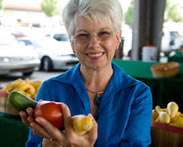Black Friday has come and gone. Personally, I’m not one to lose sleep (and possibly sanity) over saving a few bucks. Last year, I enjoyed shopping from the comfort of home. That’s right, I turned to the Internet. I bought a popcorn popper for my husband from a national chain on Black Friday, but then I went to the Amish store nearby and bought purple popcorn and flavored seasoning salt to complete the gift. This year, I hope to skip the national chains, but I loved the freedom of shopping online—no lines, no parking lots and delivery to my door (often with free shipping). This year I have been introduced to quite a few North Carolina businesses through the N.C. Value-Added Cost Share program, and I think my gift list will include a few specialty items from these growing agri-businesses. The items are local, often edible and many can be purchased online. A few of my favorites are the Farmers Roasted Soynuts (perfect stocking stuffer), essential oil of lavender, organic wine and smoked trout. You can find more N.C. ag-inspired products online at the NCDA&CS General Store, or look for a holiday farmers market near you.
One of my favorite DIY gifts is  to assemble a recipe card collection coupled with a dishtowel, hand-knitted dishcloth and a vintage mixing bowl. It’s a versatile gift, suitable for a loved one, a casual acquaintance or a blind gift exchange. This year, The Produce Lady will be my elf and she can be yours too!
to assemble a recipe card collection coupled with a dishtowel, hand-knitted dishcloth and a vintage mixing bowl. It’s a versatile gift, suitable for a loved one, a casual acquaintance or a blind gift exchange. This year, The Produce Lady will be my elf and she can be yours too!
Simply visit www.theproducelady.org. Select the recipe tab and download the printable pdfs available for select favorites. Print the recipes on card stock, trim and tie with a festive ribbon. Easy, fun and useful!
I hope you’ll join me this year thinking outside the heat-sealed plastic box for an agriculturally inspired Carolina Christmas. Only 27 shopping days left!

 easy as well. For a small batch, peel, core and slice four large, naturally sweet apples. Place in a crock pot with ¼ cup water and cook for six hours. Use a mash with a fork for a chunkier version, or blend in a food processor for a smoother texture. I found the single-serve cups available at the grocery store were convenient for travel and eating out. Applesauce is easy to swallow, but provides more texture than most baby food purees. (Remember: Whole fruit it best for maximum nutritional value, while juice should be avoided due to its high sugar content.)
easy as well. For a small batch, peel, core and slice four large, naturally sweet apples. Place in a crock pot with ¼ cup water and cook for six hours. Use a mash with a fork for a chunkier version, or blend in a food processor for a smoother texture. I found the single-serve cups available at the grocery store were convenient for travel and eating out. Applesauce is easy to swallow, but provides more texture than most baby food purees. (Remember: Whole fruit it best for maximum nutritional value, while juice should be avoided due to its high sugar content.)







